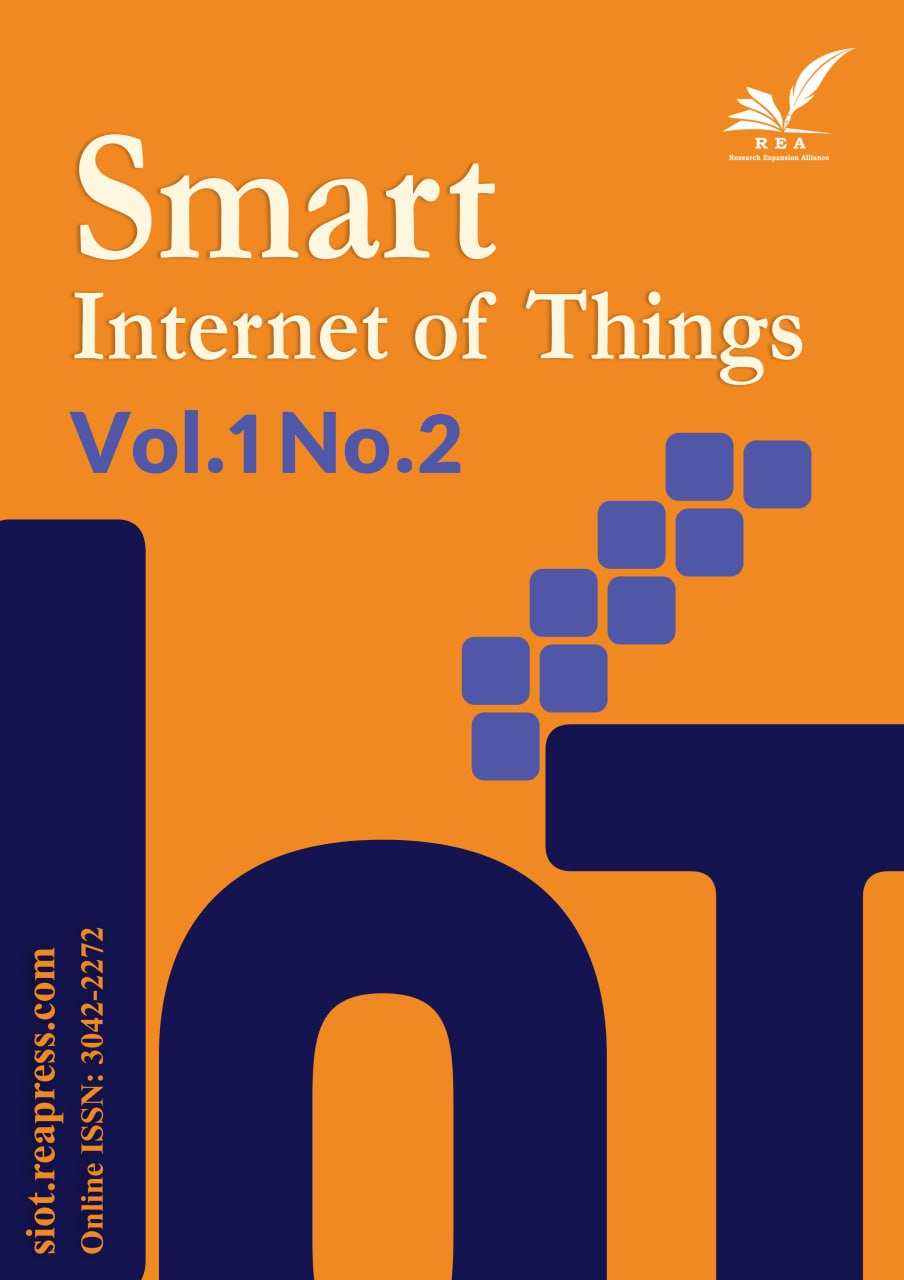A Comprehensive Study of Load Balancing Architectures in Cloud Computing
Abstract
Load Balancing is the process of effectively dividing incoming network traffic among several backend servers. Essentially, there are three types in load balancing; software, hardware and cloud-native. In order to disperse network and application traffic, a hardware load balancer uses actual hardware that is located on the premises. There are two types of software load balancers: open-source and commercial. Both require installation before use. In contrast to software load balancers, a virtual load balancer (also known as cloud-native load balancer) installs a hardware load balancing device's software on a virtual machine. The main challenge is the need to compare their performance across diverse network environments while considering factors such as scalability, cost-effectiveness, and adaptability to dynamic workloads. In our work we have proposed a comparative analysis of cloud load balancing that will help the research community to select appropriate cloud load balancing according to the applications. Software, hardware, and cloud-based each has its own advantages and limitations. Our results demonstrate that software load balancers offer flexibility and ease of deployment, hardware load balancers often provide high performance and dedicated hardware resources, while cloud-based load balancers offer scalability and integration with cloud services. Furthermore the "best" type varies depending on factors such as the scale of the network, budget constraints, performance requirements, and the specific needs of the application or service being load balanced.
Keywords:
Load balancing, Cloud computing, Cloud-native solution, Software load balancing, Hardware load balancing, Scalability, IoTReferences
- [1] Rani, S., Kumar, D., & Dhingra, S. (2022, November). A review on dynamic load balancing algorithms. 2022 international conference on computing, communication, and intelligent systems (ICCCIS) (pp. 515-520). IEEE. https://doi.org/10.1109/ICCCIS56430.2022.10037671
- [2] Rai, H., Ojha, S. K., & Nazarov, A. (2020). Comparison study of load balancing algorithm. 2020 2nd International conference on advances in computing, communication control and networking (ICACCCN) (pp. 852-856). IEEE. https://doi.org/10.1109/ICACCCN51052.2020.9362905
- [3] Rahman, M., Iqbal, S., & Gao, J. (2014, April). Load balancer as a service in cloud computing. 2014 IEEE 8th international symposium on service oriented system engineering (pp. 204-211). IEEE. https://doi.org/10.1109/SOSE.2014.31
- [4] Mohapatra, H., & Rath, A. K. (2020). Fault-tolerant mechanism for wireless sensor network. IET wireless sensor systems, 10(1), 23–30. https://doi.org/10.1049/iet-wss.2019.0106
- [5] Moharir, M., Shobha, G., Oppiliappan, A., GVL, R. M. K., Pandit, S. N., Akash, R., & Saxena, M. (2020). A study and comparison of various types of load balancers. 2020 5th ieee international conference on recent advances and innovations in engineering (ICRAIE) (pp. 1–7). IEEE. https://doi.org/10.1109/ICRAIE51050.2020.9358333
- [6] Richardson, L. (2019). What is hardware load balancer (HLD). Sage Publications. https://www.imperva.com/learn/availability/hardware-load-balancer-hld/
- [7] Mohapatra, H., & Rath, A. K. (2019). Fault tolerance in WSN through PE-LEACH protocol. IET wireless sensor systems, 9(6), 358–365. https://doi.org/10.1049/iet-wss.2018.5229
- [8] ADC, L. B. (2024). Barracuda networks. Sage Publications. https://www.barracuda.com/products/application-protection/load-balancer
- [9] Sage Publications Sage CA: Thousand Oaks, CA. (n.d.). Load balancing your applications. https://www.f5.com/solutions/use-cases/load-balancing-your-applications
- [10] Networks, A. (2023). Load balancing solutions for availability & security. Sage Publications. https://www.a10networks.com/solutions/multi-cloud/load-balancing/
- [11] Mohapatra, H., & Rath, A. K. (2019). Detection and avoidance of water loss through municipality taps in India by using smart taps and ICT. IET wireless sensor systems, 9(6), 447–457. https://doi.org/10.1049/iet-wss.2019.0081
- [12] Shafiq, D. A., Jhanjhi, N. Z., & Abdullah, A. (2022). Load balancing techniques in cloud computing environment: A review. Journal of king saud university-computer and information sciences, 34(7), 3910–3933. https://www.sciencedirect.com/science/article/pii/S131915782100046X
- [13] Shona, M., & Sharma, R. (2023). Implementation and comparative analysis of static and dynamic load balancing algorithms in sdn. 2023 international conference for advancement in technology (ICONAT) (pp. 1-7). IEEE. https://doi.org/10.1109/ICONAT57137.2023.10080430
- [14] Deepa, T., & Cheelu, D. (2017). A comparative study of static and dynamic load balancing algorithms in cloud computing. 2017 international conference on energy, communication, data analytics and soft computing (ICECDS) (pp. 3375-3378). IEEE. https://doi.org/10.1109/ICECDS.2017.8390086
- [15] Mohapatra, H., & Rath, A. K. (2020). Survey on fault tolerance-based clustering evolution in WSN. IET networks, 9(4), 145–155. https://doi.org/10.1049/iet-net.2019.0155
- [16] Contributor, S. (2020). What is load balancing? Types, configurations, and best tools-DNSstuff. Sage Publications Sage. https://www.dnsstuff.com/what-is-server-load-balancing
- [17] Afzal, S., & Kavitha, G. (2019). Load balancing in cloud computing-A hierarchical taxonomical classification. Journal of cloud computing, 8(1), 1–24. https://link.springer.com/article/10.1186/s13677-019-0146-7
- [18] Joshi, S., & Kumari, U. (2016). Load balancing in cloud computing: challenges & issues. 2016 2nd international conference on contemporary computing and informatics (IC3I) (pp. 120–125). IEEE. https://doi.org/10.1109/IC3I.2016.7917945
- [19] Ebadifard, F., & Babamir, S. M. (2021). Autonomic task scheduling algorithm for dynamic workloads through a load balancing technique for the cloud-computing environment. Cluster computing, 24, 1075–1101. https://doi.org/10.1007/s10723-015-9359-2
- [20] Singh, S., & Chana, I. (2016). A survey on resource scheduling in cloud computing: Issues and challenges. Journal of grid computing, 14, 217–264. https://doi.org/10.1007/s10723-015-9359-2
- [21] Houssein, E. H., Gad, A. G., Wazery, Y. M., & Suganthan, P. N. (2021). Task scheduling in cloud computing based on meta-heuristics: review, taxonomy, open challenges, and future trends. Swarm and evolutionary computation, 62, 100841. https://doi.org/10.1016/j.swevo.2021.100841
- [22] Mohapatra, H., & Rath, A. K. (2021). Fault tolerance in WSN through uniform load distribution function. International journal of sensors wireless communications and control, 11(4), 385–394. https://doi.org/10.2174/2210327910999200525164954
- [23] Varghese, B., & Buyya, R. (2018). Next generation cloud computing: New trends and research directions. Future generation computer systems, 79, 849–861. https://doi.org/10.1016/j.future.2017.09.020
- [24] Sehgal, N. K., Bhatt, P. C. P., & Acken, J. M. (2022). Future trends in cloud computing. In Cloud computing with security and scalability. concepts and practices (pp. 289–317). Springer. https://doi.org/10.1007/978-3-030-24612-9_13
- [25] Buyya, R., Srirama, S. N., Casale, G., Calheiros, R., Simmhan, Y., & Varghese, B. (2018). A manifesto for future generation cloud computing: Research directions for the next decade. ACM computing surveys (csur), 51(5), 1–38. https://dl.acm.org/doi/abs/10.1145/3241737
- [26] Bhari, S., & Quraishi, S. J. (2022). Blockchain and cloud computing-a review. 2022 international conference on machine learning, big data, cloud and parallel computing (com-it-con) (Vol. 1, pp. 766–770). IEEE. https://doi.org/10.1109/COM-IT-CON54601.2022.9850499
- [27] Abdalla, P. A., & Varol, A. (2019). Advantages to disadvantages of cloud computing for small-sized business. 2019 7th international symposium on digital forensics and security (ISDFS) (pp. 1–6). IEEE. https://doi.org/10.1109/ISDFS.2019.8757549
- [28] Agarwal, M., & Srivastava, G. M. S. (2017). Cloud computing: A paradigm shift in the way of computing. International journal of modern education and computer science, 9(12), 38. https://mecs-press.net/ijmecs/ijmecs-v9-n12/IJMECS-V9-N12-5.pdf
- [29] Domanal, S. G., & Ram Mohana Reddy, G. (2014). Optimal load balancing in cloud computing by efficient utilization of virtual machines. https://idr.l2.nitk.ac.in/jspui/handle/123456789/8643
- [30] Metawei, M. A., Ghoneim, S. A., Haggag, S. M., & Nassar, S. M. (2012). Load balancing in distributed multi-agent computing systems. Ain shams engineering journal, 3(3), 237–249. https://www.sciencedirect.com/science/article/pii/S2090447912000172
- [31] Liu, W., Wu, M., Ou, X., Zheng, W., & Shen, M. (2000). Design of an I/O balancing file system on web server clusters. Proceedings 2000. international workshop on parallel processing (pp. 119–125). IEEE. https://doi.org/10.1109/ICPPW.2000.869095
- [32] Waghmode, S. T., & Patil, B. M. (2021, October). Load balancıng technique in distributed systems: a review. 2021 2nd global conference for advancement in technology (GCAT) (pp. 1-7). IEEE. DOI: 10.1109/GCAT52182.2021.9587476
- [33] Nguyen, V. H., Khaddaj, S., Hoppe, A., & Oppong, E. (2011). A qos based load balancing framework for large scale elastic distributed systems. 2011 10th international symposium on distributed computing and applications to business, engineering and science (pp. 146–150). IEEE. https://doi.org/10.1109/DCABES.2011.12
- [34] Galante, G., & de Bona, L. C. E. (2012). A survey on cloud computing elasticity. 2012 ieee fifth international conference on utility and cloud computing (pp. 263–270). IEEE. https://doi.org/10.1109/UCC.2012.30
- [35] Ray, S., & De Sarkar, A. (2012). Execution analysis of load balancing algorithms in cloud computing environment. International journal on cloud computing: services and architecture (IJCCSA), 2(5), 1–13. https://www.academia.edu/download/38386371/33.pdf
- [36] Chandrasekaran, K., & Divakarla, U. (2013). Load balancing of virtual machine resources in cloud using genetic algorithm. ICCN conference at national institute of technology karnataka, surathkal (pp. 156–168). Elsevier Publications.
- [37] Semchedine, F., Bouallouche-Medjkoune, L., Sayeh, O., Ayoub, S., & Aïssani, D. (2014). DNS-based load balancing with cache for geographically distributed web server systems. 2014 global summit on computer & information technology (GSCIT) (pp. 1-6). IEEE. https://doi.org/10.1109/GSCIT.2014.6970100
- [38] Jung, J., Kiertscher, S., Menski, S., & Schnor, B. (2014). Self-adapting load balancing for DNS. International symposium on performance evaluation of computer and telecommunication systems (spects 2014) (pp. 564–571). IEEE. https://doi.org/10.1109/SPECTS.2014.6879994
- [39] Yokota, H., Kimura, S., & Ebihara, Y. (2004). A proposal of DNS-based adaptive load balancing method for mirror server systems and its implementation. 18th international conference on advanced information networking and applications (Vol. 2, pp. 208-213). IEEE. https://doi.org/10.1109/AINA.2004.1283788


